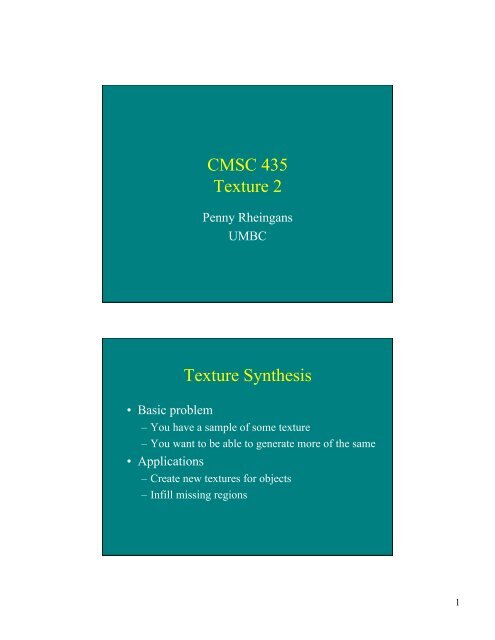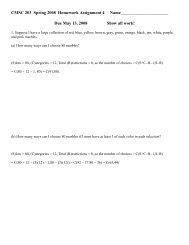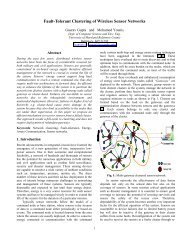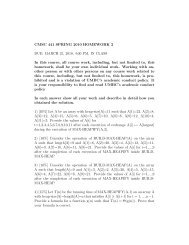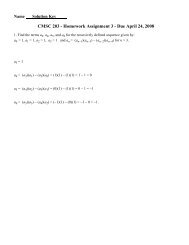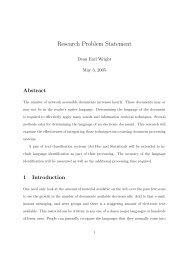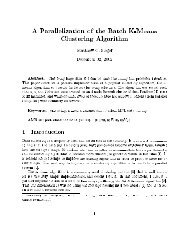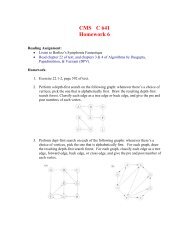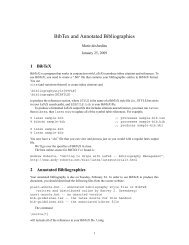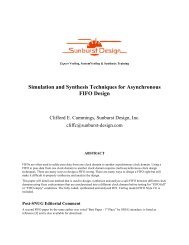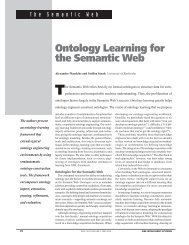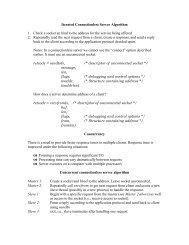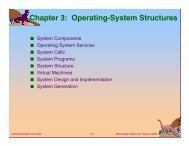CMSC 435 Texture 2 Texture Synthesis - UMBC
CMSC 435 Texture 2 Texture Synthesis - UMBC
CMSC 435 Texture 2 Texture Synthesis - UMBC
Create successful ePaper yourself
Turn your PDF publications into a flip-book with our unique Google optimized e-Paper software.
<strong>CMSC</strong> <strong>435</strong><br />
<strong>Texture</strong> 2<br />
Penny Rheingans<br />
<strong>UMBC</strong><br />
<strong>Texture</strong> <strong>Synthesis</strong><br />
• Basic problem<br />
– You have a sample of some texture<br />
– You want to be able to generate more of the same<br />
• Applications<br />
– Create new textures for objects<br />
– Infill missing regions<br />
1
Sample Replication<br />
Multiresolution <strong>Synthesis</strong><br />
• Jeremy De Bonet,<br />
SIGGRAPH ‘97,<br />
• Analyze sample to<br />
generate global<br />
conditional distribution<br />
function<br />
– joint features<br />
– multiple resolutions<br />
Synthesize texture with<br />
similar joint features<br />
2
• Uniform sampling<br />
• Frequency sampling<br />
• De Bonet 97<br />
Multiresolution <strong>Synthesis</strong><br />
De Bonet ‘97<br />
3
• De Bonet S97<br />
Results<br />
• De Bonet S97<br />
4
<strong>Texture</strong> Sampling<br />
• Alexei Efros and Thomas Leung, ICCV ‘99, <strong>Texture</strong><br />
<strong>Synthesis</strong> by Non-parametric Sampling<br />
• Their goals:<br />
– preserve local structure<br />
– model wide range of real textures<br />
– ability to do constrained synthesis<br />
• Their method:<br />
– <strong>Texture</strong> is “grown” one pixel at a time<br />
– conditional pdf of pixel given its neighbors synthesized thus far is<br />
computed directly from the sample image<br />
Synthesizing One Pixel<br />
Infinite sample<br />
image<br />
SAMPLE<br />
p<br />
Generated image<br />
– Assuming Markov property, what is conditional probability<br />
distribution of p, given the neighbourhood window?<br />
– Instead of constructing a model, let’s directly search the<br />
input image for all such neighbourhoods to produce a<br />
histogram for p<br />
– To synthesize p, just pick one match at random<br />
Efros and Leung ‘99<br />
5
Really Synthesizing One Pixel<br />
finite sample<br />
image<br />
SAMPLE<br />
p<br />
Generated image<br />
– However, since our sample image is finite, an exact<br />
neighbourhood match might not be present<br />
– So we find the best match using SSD error (weighted by a<br />
Gaussian to emphasize local structure), and take all samples<br />
within some distance from that match<br />
Efros and Leung ‘99<br />
Growing <strong>Texture</strong><br />
– Starting from the initial configuration, we “grow” the<br />
texture one pixel at a time<br />
– The size of the neighbourhood window is a parameter that<br />
specifies how stochastic the user believes this texture to be<br />
– To grow from scratch, we use a random 3x3 patch from<br />
input image as seed Efros and Leung ‘99<br />
6
Randomness Parameter<br />
Efros and Leung ‘99<br />
More <strong>Synthesis</strong> Results<br />
Increasing window size<br />
Efros and Leung ‘99<br />
7
Brodatz Results<br />
aluminum wire<br />
reptile skin<br />
Efros and Leung ‘99<br />
More Brodatz Results<br />
french canvas<br />
rafia weave<br />
Efros and Leung ‘99<br />
8
wood<br />
More Results<br />
granite<br />
Efros and Leung ‘99<br />
white bread<br />
More Results<br />
brick wall<br />
Efros and Leung ‘99<br />
9
Constrained <strong>Synthesis</strong><br />
Efros and Leung ‘99<br />
Visual Comparison<br />
Synthetic tilable<br />
texture<br />
[DeBonet, ‘97]<br />
Simple tiling<br />
Our approach<br />
Efros and Leung ‘99<br />
10
Failure Cases<br />
Growing garbage<br />
Verbatim copying<br />
Efros and Leung ‘99<br />
Homage to Shannon<br />
Efros and Leung ‘99<br />
11
Characteristics<br />
• High quality results which capture much of<br />
structure of input image<br />
• Really slow<br />
– 192x192 image from 64x64 sample == 1941 sec<br />
TVG <strong>Texture</strong> <strong>Synthesis</strong><br />
• Li-Yi Wei and Marc Levoy, SIGGRAPH ‘00,<br />
– Fast <strong>Texture</strong> <strong>Synthesis</strong> using Tree-structured Vector<br />
Quantization,<br />
• Characteristics<br />
– Multiresolution search approach<br />
– Accelerate with tree-structured vector<br />
quantization<br />
12
Basic Approach<br />
• Transform random input texture to output<br />
by matching causal neighborhood of next<br />
pixel<br />
Wei and Levoy ‘00<br />
Wei and Levoy ‘00<br />
13
Effect of Neighborhood Size<br />
5x5 7x7 9x9<br />
Wei and Levoy ‘00<br />
Multiresolution Neighborhood<br />
Wei and Levoy ‘00<br />
14
Effect of # of Pyramid Levels<br />
• Quality improves as number of levels<br />
increases<br />
1 2 3<br />
Wei and Levoy ‘00<br />
Results<br />
Wei and Levoy ‘00<br />
15
Results<br />
Wei and Levoy ‘00<br />
Results<br />
Wei and Levoy ‘00<br />
16
Wei and Levoy ‘00<br />
Wei and Levoy ‘00<br />
17
Heeger & Bergen De Bonet Efros & Leung Wei & Levoy<br />
Wei and Levoy ‘00<br />
Acceleration<br />
• Limit neighborhood searched exhaustively<br />
– Causal neighborhood<br />
– Represent as vector<br />
– 192x192 from 64x64 sample == 503 sec<br />
• Recast problem as nearest-neighbor search<br />
• Accelerate with TSVQ<br />
– Generate binary tree-structured codebook from<br />
training vectors<br />
– For each output pixel, search tree for nearest<br />
match<br />
– 192x192 from 64x64 sample == 24 sec<br />
18
Wei and Levoy ‘00<br />
<strong>Synthesis</strong> on Arbitrary Surfaces<br />
• Greg Turk, SIGGRAPH ‘01<br />
– <strong>Texture</strong> <strong>Synthesis</strong> on Surfaces<br />
• Basic Approach<br />
– Modify hierarchical sampling approach to<br />
replay image pyramid with mesh pyramid<br />
– Select color at a point by matching<br />
neighborhood in mesh<br />
– Resulting texture naturally follows shape of<br />
object<br />
19
Mesh Hierarchy<br />
• Generate hierarchy of points from low to high<br />
density<br />
• Connect points to create hierarchy of meshes<br />
• <strong>Texture</strong> generated in coarse-to-fine manner<br />
Turk ‘01<br />
User-specified Vector Field<br />
• Vector field indicates orientation of texture<br />
(order of point visitation)<br />
• <strong>Texture</strong> grows along vector field<br />
Turk ‘01<br />
20
Turk ‘01<br />
Turk ‘01<br />
21
Turk ‘01<br />
Turk ‘01<br />
22
Image Analogies<br />
• Aaron Hertzmann, Charles Jacobs, Nuria Oliver,<br />
Brian Curless, and David Salesin, SIGGRAPH<br />
2001.<br />
• Apply texture synthesis techniques to reproduce<br />
transformation operation from example<br />
The Problem<br />
• Given a pair of images A and A’ (the<br />
unfiltered and filtered source images,<br />
respectively), along with some additional<br />
unfiltered target image B, synthesize a new<br />
filtered target image B’ such that<br />
• Questions<br />
A : A’ :: B : B’<br />
– How to measure similarity between source<br />
images (A, A’)?<br />
– How to compare unfiltered images (A, B)?<br />
23
Basic Process<br />
• Training phase<br />
– Selection of source images<br />
– Annotation as necessary<br />
– Filter created<br />
• Application phase<br />
– Filter applied to target<br />
The Method<br />
24
Matching<br />
• BestApproximateMatch<br />
– Approximate nearest neighbor (ANN)<br />
– Tree-structured vector quantization (TSVQ)<br />
• BestCoherenceMatch<br />
– Pick match that best continues pixels already<br />
generated<br />
Features<br />
• RGB didn’t work well<br />
– Not enough good matches<br />
• Alternatives<br />
– Luminance (chromatic info just copied from B)<br />
• Optional luminance remapping<br />
– Orientable filters<br />
25
Image Filtering<br />
• Blur<br />
Image Filtering<br />
• Emboss<br />
26
<strong>Texture</strong> <strong>Synthesis</strong> Results<br />
Super-Resolution<br />
27
Artistic Filters<br />
Painting-by-Example<br />
28
Painting-by-<br />
Example<br />
29
<strong>Texture</strong>-by-Example<br />
30
Limitations<br />
• Performance range: seconds to hours<br />
• Only captures low-level statistical image<br />
features<br />
• Similarity metric doesn’t match perception<br />
• Requires registered source images<br />
Project Website<br />
• URL<br />
– www.grail.cs.washington.edu/projects/imageanalogies<br />
• Contains<br />
– More examples<br />
– Software<br />
31


